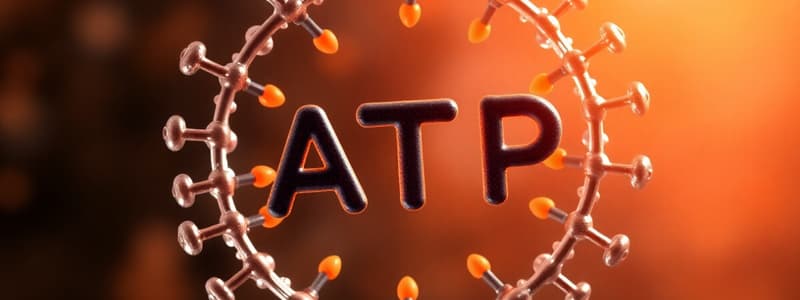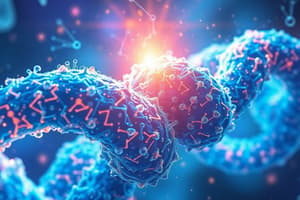Podcast
Questions and Answers
What three components constitute a molecule of ATP?
What three components constitute a molecule of ATP?
- Adenine base, ribose sugar, three phosphate groups (correct)
- Guanine base, deoxyribose sugar, two phosphate groups
- Cytosine base, ribose sugar, two phosphate groups
- Thymine base, deoxyribose sugar, four phosphate groups
What is the primary role of ATP in cells?
What is the primary role of ATP in cells?
- Storing genetic information
- Transporting oxygen
- Synthesizing proteins
- Providing energy for cellular processes (correct)
How is energy released from ATP?
How is energy released from ATP?
- By converting into kinetic energy
- By binding to an enzyme
- By hydrolysis to ADP and inorganic phosphate (correct)
- By adding a phosphate group to form AMP
What is potential energy?
What is potential energy?
Which law of thermodynamics states that energy cannot be created or destroyed?
Which law of thermodynamics states that energy cannot be created or destroyed?
What is a decomposition reaction?
What is a decomposition reaction?
What type of reaction involves the transfer of electrons between molecules?
What type of reaction involves the transfer of electrons between molecules?
What is an anabolic reaction?
What is an anabolic reaction?
Which term describes reactions that release energy?
Which term describes reactions that release energy?
What characterizes a reversible reaction?
What characterizes a reversible reaction?
Which statement best describes an irreversible reaction?
Which statement best describes an irreversible reaction?
What is the role of activation energy in a chemical reaction?
What is the role of activation energy in a chemical reaction?
How do enzymes increase the rate of biochemical reactions?
How do enzymes increase the rate of biochemical reactions?
What is the primary structural component of enzymes?
What is the primary structural component of enzymes?
Where does the substrate bind on an enzyme?
Where does the substrate bind on an enzyme?
What happens to the reaction rate as substrate concentration increases, assuming enzyme concentration remains constant?
What happens to the reaction rate as substrate concentration increases, assuming enzyme concentration remains constant?
What is the likely effect on enzyme activity if the temperature is significantly higher than the enzyme's optimal temperature?
What is the likely effect on enzyme activity if the temperature is significantly higher than the enzyme's optimal temperature?
How does a competitive inhibitor affect enzyme activity?
How does a competitive inhibitor affect enzyme activity?
Where does a noncompetitive inhibitor bind to an enzyme?
Where does a noncompetitive inhibitor bind to an enzyme?
In metabolic pathways, how does negative feedback typically regulate the pathway's activity?
In metabolic pathways, how does negative feedback typically regulate the pathway's activity?
Flashcards
ATP Structure
ATP Structure
ATP consists of adenine, ribose sugar, and three phosphate groups.
Function of ATP
Function of ATP
ATP is the primary energy currency of cells for processes like muscle contraction and transport.
ATP Energy Storage
ATP Energy Storage
ATP stores energy in the bonds between phosphate groups.
ATP Hydrolysis
ATP Hydrolysis
Signup and view all the flashcards
Potential Energy
Potential Energy
Signup and view all the flashcards
Kinetic Energy
Kinetic Energy
Signup and view all the flashcards
First Law of Thermodynamics
First Law of Thermodynamics
Signup and view all the flashcards
Second Law of Thermodynamics
Second Law of Thermodynamics
Signup and view all the flashcards
Synthesis Reactions
Synthesis Reactions
Signup and view all the flashcards
Catabolic Reactions
Catabolic Reactions
Signup and view all the flashcards
Irreversible reaction
Irreversible reaction
Signup and view all the flashcards
Reaction rate
Reaction rate
Signup and view all the flashcards
Activation energy
Activation energy
Signup and view all the flashcards
Catalyzed reaction
Catalyzed reaction
Signup and view all the flashcards
Uncatalyzed reaction
Uncatalyzed reaction
Signup and view all the flashcards
Enzyme structure
Enzyme structure
Signup and view all the flashcards
Enzyme function
Enzyme function
Signup and view all the flashcards
Active site
Active site
Signup and view all the flashcards
Competitive inhibition
Competitive inhibition
Signup and view all the flashcards
Metabolism
Metabolism
Signup and view all the flashcards
Study Notes
ATP Structure and Function
- ATP (adenosine triphosphate) is composed of an adenine base, a ribose sugar, and three phosphate groups.
- Phosphate groups are connected by high-energy bonds.
- ATP is the primary energy currency in cells.
- It provides energy for various cellular processes (muscle contraction, transport, chemical reactions).
- Energy is stored in the bonds between phosphate groups.
- Hydrolysis of ATP (breaking the bond) releases energy in the form of ADP (adenosine diphosphate) and an inorganic phosphate (Pi).
Energy Types and Thermodynamics
- Potential energy is energy stored due to position or structure (e.g., chemical bonds).
- Kinetic energy is energy of motion (e.g., moving particles, heat).
- The first law of thermodynamics states energy cannot be created or destroyed, only transformed.
- Chemical potential energy in glucose can be transformed into ATP and heat.
- The second law of thermodynamics states transformations are inefficient. Some energy is lost as heat, increasing disorder (entropy).
Chemical Reactions
- Synthesis reactions combine reactants to form a larger molecule.
- Decomposition reactions break down a large molecule into smaller ones.
- Exchange reactions involve breaking and reforming bonds.
- Oxidation-reduction (redox) reactions involve electron transfer.
- Anabolic reactions build complex molecules (require energy).
- Catabolic reactions break down complex molecules (release energy).
- Endergonic reactions require energy input.
- Exergonic reactions release energy.
- Reversible reactions can proceed in both directions.
- Irreversible reactions proceed in only one direction.
Enzymes and Reaction Rates
- Reaction rate is the speed of reactant conversion to products.
- Activation energy is the minimum energy needed to start a reaction.
- Catalyzed reactions are accelerated by a catalyst (e.g., enzymes).
- Uncatalyzed reactions occur without a catalyst, typically at a slower rate.
- Enzymes are proteins with a specific 3-dimensional structure.
- The active site is the region where substrates bind.
- Enzymes lower activation energy, speeding up biochemical reactions.
- Factors affecting enzyme activity include substrate concentration, temperature, pH.
Enzyme Inhibition and Metabolism
- Competitive inhibition blocks substrate binding to the active site.
- Noncompetitive inhibition binds to a site other than the active site, changing the enzyme's shape.
- Metabolism is the sum of all chemical reactions in a cell or organism.
- Metabolic pathways often utilize negative feedback mechanisms.
- Final products inhibit earlier steps in the pathway to regulate activity.
Enzyme Mechanism
- Substrates bind to the enzyme's active site.
- Enzyme-substrate complex forms, lowering activation energy
- Products are released.
- Cofactors (non-protein molecules) assist enzymes in catalysis.
Studying That Suits You
Use AI to generate personalized quizzes and flashcards to suit your learning preferences.




